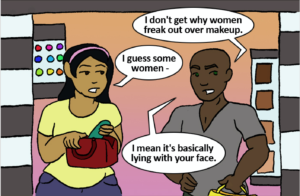
Credit: Trans Griot
Throwback Thursday: This article was originally published on 8/2/2012.
Nearly one million adults in the US identify as transgender.
And yet, most people know almost nothing about them.
Even many feminists have trouble distinguishing identity from identity, term from term, myth from reality.
How many of your friends and family can properly define the term “transgender?”
If you’re like most of us, the answer is, not many.
Why do we know so little about transgender people?
When it comes to gender and sex, transgender people are breaking the rules. And since patriarchy’s very existence depends on everyone’s compliance, those who break the rules are a threat.
So they must be silenced.
Transgender people are systematically silenced on a daily basis.
They are not adequately represented in politics, government, or media. They are not encouraged to freely express themselves in a society that fears them. They are often not even safe on their own streets.
We don’t know them because, frankly, we don’t see them.
When transgender people do live their lives in the open, they are deemed freaks, deviants, and perverts. They are told that who they are is wrong. They are even hated, hurt, and killed.
When transgender people are represented in the media, they are often portrayed as over-sexualized, uncontrollable freaks (think “Jerry Springer”). Or are presented as drugged out prostitutes (think “Cops”). Or are misidentified as flamboyant drag queens (think “RuPaul”).
We know this is wrong.
But, we may still not know what’s right.
It’s easy to fall into the trap of stereotyping this group that you may find hard to understand. Maybe you already have.
That’s okay. Being feminist doesn’t mean being perfect. But it does mean making an effort to change your ways of thinking and debunk the myths that society tells us about certain groups of people.
So let’s confront some of the most common myths about transgender people, and change our ways of thinking about them.
Myth #1: Transgender people live crazy lives.
This is probably the most common misconception about trans people.
Many people incorrectly associate being transgender with automatically living an “crazy lifestyle” based on tv and in the movies. This may involve drag performance, hyper-masculine or hyper-feminine behavior, drugs, or prostitution.
Some trans people (and some non-trans people too!) engage in the above behaviors. But all transgender people do the everyday things that are a part of life. They go to work, buy groceries, see movies, kiss their kids good night.
They are people. They do people things like everyone else.
Myth #2: Transgender people are confused.
Just because a person is different, doesn’t mean they don’t know who they are.
Trans people have a sex. They are females, males, and intersex.
Trans people have a gender. They are men, women, queer, and other genders.
They know their sex and they know their gender.
This can be confusing to us who inhabit more traditional gender roles, but to the transgender person, it is not confusing. It is just who they are.
That said, coming to the realization that you are trans, and coming out publically as trans, in a society that doesn’t accept or understand you can be very confusing and hurtful. Many transgender people have experiences of feeling “defective” or “wrong.”
This is a social problem, not a gender identity problem.
Myth #3: Transgender people are mentally disturbed.
It’s true that many transgender people suffer from mental illness. But it’s not because of their gender identity alone!
It’s because in a patriarchal society, being gender variant causes a lot of distress. So much distress, in fact, that it can be described by the diagnosis of a mental disorder. This diagnosis is helpful because it tells us that this person is hurting and something needs to be done to help.
Transgender people have the same brains we do. They are just faced with a lot more mental and emotional stress.
Myth #4: Transgender people are gay.
Gender identity and sexual orientation are two completely separate characteristics. One is what gender we see ourselves as being. The other is what gender(s) and sex(es) we are physically and romantically attracted to.
Knowing one doesn’t tell you about the other.
Myth #5: Transgender people are radical liberals with crazy ideas.
Transgender people come from all political and religious backgrounds.
Many trans people just want to lead their lives as part of “mainstream” society and be accepted and not condemned by their families, churches, governments and communities.
They should be allowed this.
Other trans people feel very strongly about changing the system that has oppressed them and adapt more radical beliefs about the gender system. They wish to live outside of traditional social norms and not be deemed “freaks” because of it.
They should be allowed this too.
Transgender people are diverse. Each will make a unique decision about the life they want to lead.
Myth #6: Transgender people hate their bodies.
This is a very common myth. It does make sense that a person who identifies as a woman might be uncomfortable in her male body, and vice versa. And some transgender people are uncomfortable and want to alter their bodies. Others choose to live with their bodies as they are.
Neither choice means that this person hates themself. On the contrary, a transgender person can love themselves through the whole process of transitioning. And we can love them too!
Each person’s relationship with their body is unique and we should support every transgender person in doing what works for them.
Myth #7: Transgender people perform drag shows.
Conservative thinkers would love to point to a singing, shimmying, scantily dressed, heavily made-up drag queen slinking across a stage and say, “THAT is a transgender!” But, they’re wrong. In fact, did you know that the majority of gender performance is done by non-trans people?
Because, it’s just a performance. It’s not about real people.
Drag Queens and Drag Kings “do drag” for theatrical, comedic, and at times, political purposes. They do it for their art and they do it with you, the viewer, in mind.
When a trans woman wears women’s clothing or a trans man wears men’s clothing, they are not doing drag. Nor are they cross-dressing. They are just wearing their clothes.
Myth #8: You can tell someone is transgender just by looking at them.
This is a myth meant to make us believe that transgender people are all crazy freaks. That you can “spot” one, like a cartoon villain or a sasquatch. “Look, a tranny!”
It is a hurtful and misleading lie.
The truth is, transgender people have bodies just like ours. And they may display them in very traditional ways.
Some pass very well, others don’t.
As feminists, we don’t judge our bodies or anyone else’s.
Myth #9: Transgender people aren’t “real” men or women.
This is probably the most hurtful myth of all. It tells us that transgender people are somehow less human because of their gender identification. It is proof that they do not have a place in proper society.
It is hateful and unacceptable.
Everyone should have the right to be men and women, regardless of sex category or anything else.
There are many ways to be human.
Myth #10: Transgender people are weird.
When someone is unlike anything we have seen or known, we think, that’s weird.
It’s okay to have that thought. It’s human nature. But it’s important to understand that your perception of what’s “weird” is based on your experiences and your culture.
Many cultures think that living outside the gender binary (two-gender system) is perfectly normal. Transgender people are integrated into mainstream society and may even be held in high esteem.
We can do the same! As feminists, we think difference is good! (and we embrace weirdness too).
Why do these myths exist?
These myths all have one thing in common: they justify the subjugation of transgender people.
Think about it: if we all believed that transgender people were confused, crazy, mentally ill, radical freaks that aren’t real people, then why would we want them to have an equal place in our society? If they’re not normal, and not right, why would we want them to be anything more than invisible?
It’s a calculated collection of stereotypes that serves to maintain patriarchy.
Just by knowing that these 10 myths are false, you know more about transgender people than most people in the country today.
And, because of this knowledge, trans people are one step closer to being understood and accepted in mainstream society.
Now, take a minute to think about how powerful that is.
Want to discuss this further? Login to our online forum and start a post! If you’re not already registered as a forum user, please register first here.
Katy Kreitler is a Contributing Writer for Everyday Feminism as well as a counselor and youth advocate. She can be found wandering the streets of San Francisco with a purse full of used fiction, a pair of emergency yoga pants, and half a burrito.
Search our 3000+ articles!
Read our articles about:
Our online racial justice training
Used by hundreds of universities, non-profits, and businesses.
Click to learn more




















